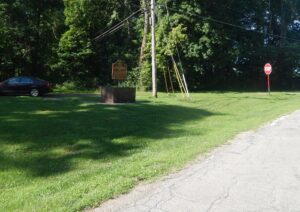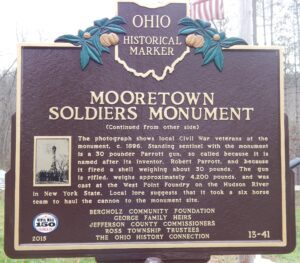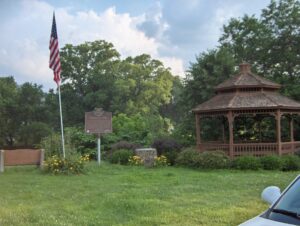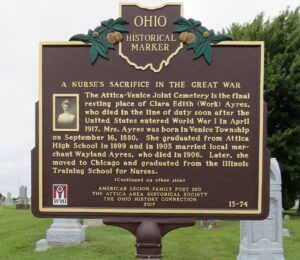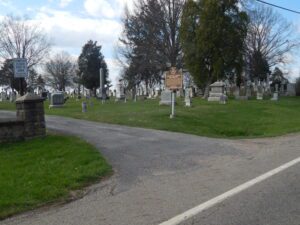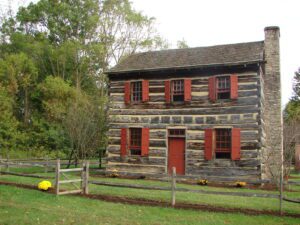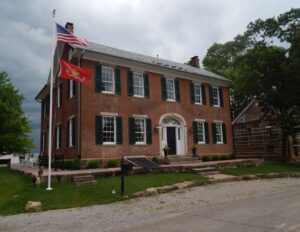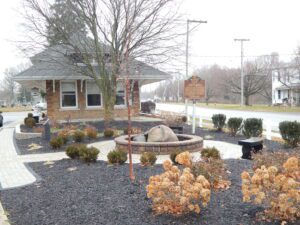, OH
Alexander Sutherland (1767-1845) and his wife Sarah (1768-1836) were the first settlers in Newton Township, Trumbull County, Ohio. Coming from Westmoreland County, Pennsylvania, the Sutherlands acquired 205 acres of land along Duck Creek southward from this site. Alexander was an influential person in the area after the settlement was made at Duck Creek. He was the second Recorder and the first elected Surveyor for Trumbull County. He was an early Mason with Old Erie Lodge, Warren schoolteacher, postmaster at Newton, Newton Township Trustee and Clerk, and Justice of the Peace. Sutherland, along with Ezekiel Hover, marked the first path from this Duck Creek settlement to Youngstown to reach the nearest mill.
, OH
In 1871 Robert and Martha McLaughlin George erected a Soldiers Monument in the memory of their son Thomas and other soldiers from Ross Township, Jefferson County, Ohio who died in service to the United States during the Civil War. All were native to Ross Township and some, like 25 year-old Thomas George, were members of Company K, 2nd Ohio Volunteer Infantry. Captain David Mitchell commanded Company K, whose recruits came from Mitchell’s Sald Works (Holt) and Yellow Creek. The unit fought in many battles, including Perryville, Kentucky, Stone River, Tennessee, Chickamauga, Georgia, and in the Atlanta campaign. Corporal Thomas George was killed at Perryville on October 8, 1862. Many of his comrades were killed in battle; others parished from disease or died as prisoners of war.
, OH
First surveyed in 1849, Powhatan Point was laid out by Franklin Knox. The “point” is the confluence of Captina Creek and the Ohio River. The small but thriving river and farming community served York Township and the rich Captina Valley as a shipping center for its first 75 years. Given impetus by the construction of the Powhatan Enterprise Flouring Mill and Woolen Factory in 1850, local businesses shipped grain, fruit, lumber, cheese, whiskey, livestock, wool, and tobacco to northern and southern ports. There were three boat landings: Boger’s, Hornbrook’s and Dorsey’s, each equipped with an incline car track from the warehouses to the river’s edge. With the opening of North American Coal Corporation’s Powhatan No. 1 Mine in 1922, the village became a mining community that continued to rely on the river. A disastrous mine fire took the lives of 66 men on July 5, 1944.
, OH
The Attica-Venice Joint Cemetery is the final resting place of Clara Edith (Work) Ayres, who died in the line of duty soon after the United States entered World War I in April 1917. Mrs. Ayres was born in Venice Township on September 16, 1880. She graduated from Attica High School in 1899 and in 1903 married local merchant Wayland Ayres, who died in 1906. Later, she moved to Chicago and graduated from the Illinois Training School for Nurses. (Continued on other side)
, OH
On July 3, 1872, 16 men and a 9-year old boy descended the 170 foot shaft in the Atwater Coal Company Mine located in Atwater Township south of Route 224 and East of Route 225. The mine was situated on the property known as the S.G. Shaffer Farm. By mid-day, 7 miners survived the brutal fire in the mine. Richard Roberts, Robert Roberts, William Roberts, Thomas Maines, Joseph Otey, John Williams, John Howells, John Jones and 9-year old George Hufford gave their lives to the first Mining Disaster in Ohio and the 19th mining disaster in the United States since 1839 with more than 5 fatalities. In 1873, Ohio was the second State to pass a law for the safety of Miners.
, OH
Zachariah Price DeWitt was born of a Dutch family in New Jersey in 1768. With brothers Jacob and Peter, he migrated to Kentucky where, in 1790, he married Elizabeth Teets, who was born in Pennsylvania in 1774. By 1805 all three brothers had settled in Ohio near Four Mile (Talawanda) Creek. Here Zachariah and Elizabeth raised corn, hogs, and eventually, nine children. Zachariah became a prominent community leader, operating a sawmill, building houses in Oxford, serving as Masonic Lodge secretary, and commanding a rifle company during the War of 1812. Tradition has it that Elizabeth wore a black sunbonnet to cover a scar from having been scalped as a child in Kentucky. Elizabeth died in 1843, followed by Zachariah in 1851. Both are buried in Darrtown Cemetery.
, OH
Erected in 1828, the Randolph Mitchell House is a five-bay, Federal-style “I” house. Its facade features a doorway with an Adam-style fan and sidelights. The interior boasts a grand stairway in the foyer and fine woodwork throughout. Randolph Mitchell (1796-1847) was born in Rockingham County, Virginia. In 1819, Mitchell and his mother Sarah (1765-1844), settled in New Reading and he married Lydia Witmer (1798-1872). They had four children. A merchant, Mitchell kept an ample smokehouse and owned a tannery and real estate. He served as a justice of the peace for Reading Township. After Mitchell’s death, his son-in-law, Dr. W.W. Arnold (1818-1872) maintained his practice in the home, where he and Caroline Mitchell Arnold (1825-1888) lived. Their son William Arnold (1858-1948) acquired the house, which remained in the family until 1951. The property was listed on the National Register of Historic Places in 1978.
, OH
On March 20, 1868, The Ohio General Assembly passed a revision to the Ohio Revised Code allowing for a municipality and a township to join together in purchasing land for a shared cemetery. On April 24, 1868, the Washington Township Trustees passed a resolution creating Forest Hill Union Cemetery. This cemetery was to be shared with the City of Piqua and became the first mutual cemetery between a municipality and a township in Ohio.


